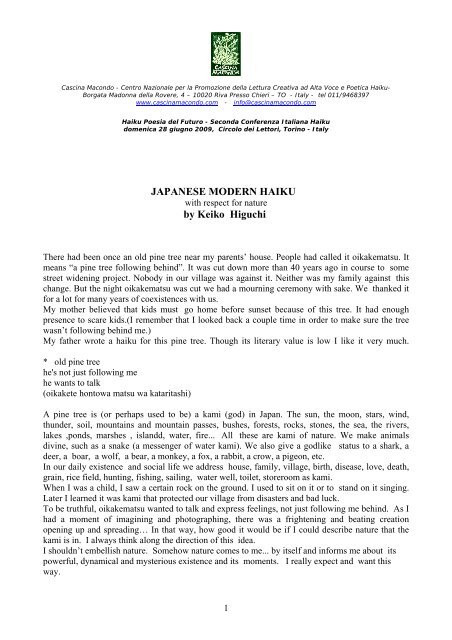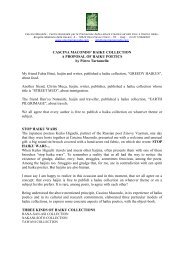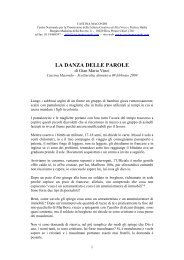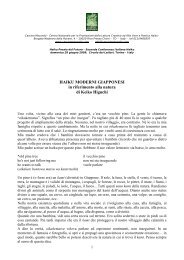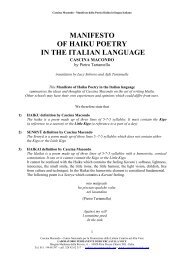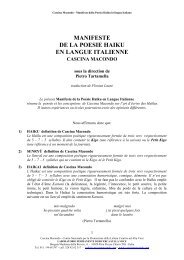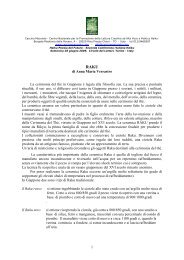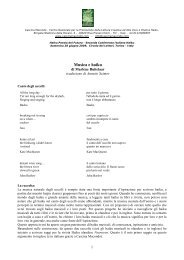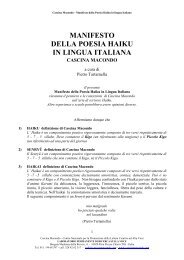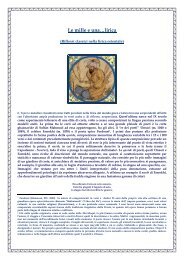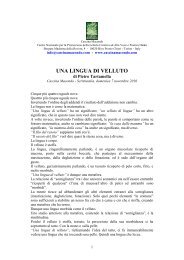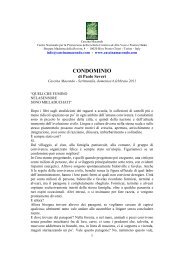JAPANESE MODERN HAIKU by Keiko Higuchi - Cascina Macondo
JAPANESE MODERN HAIKU by Keiko Higuchi - Cascina Macondo
JAPANESE MODERN HAIKU by Keiko Higuchi - Cascina Macondo
You also want an ePaper? Increase the reach of your titles
YUMPU automatically turns print PDFs into web optimized ePapers that Google loves.
<strong>Cascina</strong> <strong>Macondo</strong> - Centro Nazionale per la Promozione della Lettura Creativa ad Alta Voce e Poetica Haiku-<br />
Borgata Madonna della Rovere, 4 – 10020 Riva Presso Chieri – TO - Italy - tel 011/9468397<br />
www.cascinamacondo.com - info@cascinamacondo.com<br />
Haiku Poesia del Futuro - Seconda Conferenza Italiana Haiku<br />
domenica 28 giugno 2009, Circolo dei Lettori, Torino - Italy<br />
<strong>JAPANESE</strong> <strong>MODERN</strong> <strong>HAIKU</strong><br />
with respect for nature<br />
<strong>by</strong> <strong>Keiko</strong> <strong>Higuchi</strong><br />
There had been once an old pine tree near my parents’ house. People had called it oikakematsu. It<br />
means “a pine tree following behind”. It was cut down more than 40 years ago in course to some<br />
street widening project. Nobody in our village was against it. Neither was my family against this<br />
change. But the night oikakematsu was cut we had a mourning ceremony with sake. We thanked it<br />
for a lot for many years of coexistences with us.<br />
My mother believed that kids must go home before sunset because of this tree. It had enough<br />
presence to scare kids.(I remember that I looked back a couple time in order to make sure the tree<br />
wasn’t following behind me.)<br />
My father wrote a haiku for this pine tree. Though its literary value is low I like it very much.<br />
* old pine tree<br />
he's not just following me<br />
he wants to talk<br />
(oikakete hontowa matsu wa kataritashi)<br />
A pine tree is (or perhaps used to be) a kami (god) in Japan. The sun, the moon, stars, wind,<br />
thunder, soil, mountains and mountain passes, bushes, forests, rocks, stones, the sea, the rivers,<br />
lakes ,ponds, marshes , islandd, water, fire... All these are kami of nature. We make animals<br />
divine, such as a snake (a messenger of water kami). We also give a godlike status to a shark, a<br />
deer, a boar, a wolf, a bear, a monkey, a fox, a rabbit, a crow, a pigeon, etc.<br />
In our daily existence and social life we address house, family, village, birth, disease, love, death,<br />
grain, rice field, hunting, fishing, sailing, water well, toilet, storeroom as kami.<br />
When I was a child, I saw a certain rock on the ground. I used to sit on it or to stand on it singing.<br />
Later I learned it was kami that protected our village from disasters and bad luck.<br />
To be truthful, oikakematsu wanted to talk and express feelings, not just following me behind. As I<br />
had a moment of imagining and photographing, there was a frightening and beating creation<br />
opening up and spreading… In that way, how good it would be if I could describe nature that the<br />
kami is in. I always think along the direction of this idea.<br />
I shouldn’t embellish nature. Somehow nature comes to me... <strong>by</strong> itself and informs me about its<br />
powerful, dynamical and mysterious existence and its moments. I really expect and want this<br />
way.<br />
1
a wild boar comes<br />
and feasts on airspring<br />
mountain pass<br />
Tohta Kaneko<br />
(shishi ga kite kuki wo taberu haru no tohge)<br />
stepping on a vine<br />
the dew on the whole mountain<br />
stirred all at once<br />
Sekitei Hara<br />
(tsuru funde ichizan no tsuyu ugokikeri)<br />
the leaves will never<br />
cease to fall- do not make haste<br />
don't ever hasten!<br />
Syuson Katoh<br />
(konoha furiyamazu isogunayo isogunayo)<br />
a wolf<br />
with a single firefly<br />
clinging to it<br />
Tohta Kaneko<br />
(ohkamini hotaru ga hitotsu tsuite ita)<br />
with a piece of stone<br />
the burning red dragonfly<br />
has fallen in love<br />
Hakusen Watanabe<br />
(aru ishini akakku horetaru tombo kana)<br />
one day<br />
a nameless spring mountan<br />
began to smile<br />
Nobuko Katsura<br />
(aruhi yori warai hajimeshi nanakiyama)<br />
cutting<br />
the white leeks<br />
like shafts of light<br />
Momoko Kuroda<br />
(shironegi no hikari no boh wo ima kizamu)<br />
2
to a youth<br />
a spring bird<br />
comes and introduces itself<br />
Nana Naruto<br />
(seinen ni haru no tori kite na tsugerikeri)<br />
blowing from behind<br />
the autumn wind tells me<br />
to get on board<br />
Matsuo Takano<br />
(ushiro yori kite akikaze noreto iu)<br />
god of the toilet<br />
with a round face<br />
autumn persimmon<br />
Shizuo Miyasaka<br />
(secchin no kami wa marugao kaki no aki)<br />
My father already followed oikakematsu in his own human passing. His photo is on the Buddhist<br />
altar now. My mother never forgets offering a glass of water and meal for him every day. She prays<br />
with palms put together. Fresh flowers always sit near his photo.<br />
Many people in Japan believe that they become kami ( or hotoke) after their deaths.<br />
Ichiro Hori, an ethnologist, explained this in his book “Japanese Shamanism” <strong>by</strong> quoting Charles<br />
Eliot’s words “Most of the Japanese who almost never had interest in Buddhism and rarely visited<br />
temples in their lifetime are buried according to the funeral customs of Buddhism and most of the<br />
families”. Buddhist altars are not intended for the Buddhist images to be enshrined. They are no<br />
more than shelves for a memorial tablet of the deceased. People call dead people “hotoke sama”<br />
without any doubt and use such expressions as “hotoke’s curse” which means “consolation for<br />
hotoke” commonly.<br />
Generally, this fearless expression hotoke” instead of dead person is used only in Japan among<br />
Buddhist countries as far as I (and Charles Eliot) know. It is nothing but imitation of Shinto.<br />
Dead person becomes kami in Shinto. So Buddhist people couldn’t put dead people in the lower<br />
status than shinto’s dead people. kami and hotoke is completely the same for the Japanese people.”<br />
*<br />
newly picked tea leaves<br />
first cup<br />
offered on the Buddhist altar<br />
Tokiko Hirata<br />
(shincha kumu mazu issen wa mihotokeni)<br />
[ Tsuchibina, Clay Hina Doll, Umeda Printing Factory,1-5-18,Fukushima,Fukushimaku,Osaka,553-0003<br />
Japan, 2000 , translation <strong>by</strong> Masaharu Hirata]<br />
3
\on the waste land<br />
both stones and dead<br />
rise in the wind<br />
Sosyu Takaya<br />
(arechinite ishi mo shinin mo kaze hassu)<br />
moonrisetogether<br />
with the dead<br />
awaiting a train<br />
Murio Suzuki<br />
(tsukinode ya shindamonora to kisha wo matsu)<br />
another one<br />
of the deceased coming <strong>by</strong><br />
and dancin<br />
Kazuko Nishimura<br />
(matahitori mohja kitarite odorukana)<br />
the dead sprit<br />
entered into me is healthyblue<br />
sky as always<br />
Kohji Takahara<br />
(bokuni noru yurei sukoyaka itsumono sora)<br />
butterflies flutter<br />
while talk<br />
with the dead<br />
Hakkoh Yokoyama<br />
(cho hirahira kojin to katari orutokini)<br />
in the offing<br />
the father lives<br />
once a day<br />
in the offing the sun sets<br />
Shigenobu Takayanagi<br />
(okini chichi ari hini ichido okini hiwa ochi)<br />
"kagemusha" vanished,<br />
"kurosawa" has vanished<br />
into the lightning-flash<br />
Aiko Kumagai<br />
(inazuma e kagemusha kie kurosawa kie)<br />
4
a firefly comescarrying<br />
the sorrow<br />
of my brother<br />
Momoko Kuroda<br />
(hotaru kuru anino kanashimi sagete kuru)<br />
after I have gone<br />
at the foot of the mountains<br />
cherry trees in bloom<br />
Sumio Mori<br />
(warenakute yamabeno sakura sakinikeri)<br />
It is my long-cherished desire to describe my feelings in my words via nature. And I know nothing<br />
better for that than haiku.<br />
a snail<br />
dreams a blue dream<br />
on the back of a leaf<br />
R.H. Blyth<br />
----------------------------------<br />
All haiku, except the marked (*) ones, are from the books<br />
The Haiku Universe for the 21st Century<br />
Japanese/English <strong>JAPANESE</strong> <strong>HAIKU</strong> 2001/2008<br />
Edited <strong>by</strong> Modern Haiku Association<br />
(Gendai Haiku Kyokai)<br />
6-5-4 Kairaku Bldg. Soto Kanda Chiyoda-ku, Tokyo, 101-0021 Japan<br />
<strong>Cascina</strong> <strong>Macondo</strong> - Seconda Conferenza Italiana Haiku<br />
domenica 28 giugno 2009, Circolo dei Lettori, Torino - Italy<br />
5


